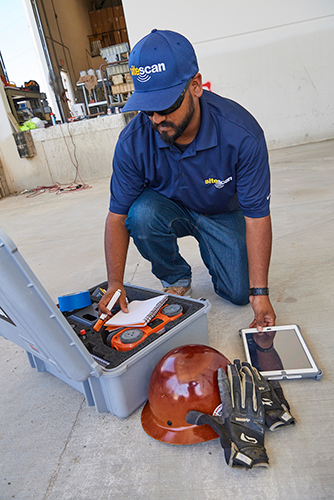Effective Concrete Scanning Techniques for Construction Tasks
Effective Concrete Scanning Techniques for Construction Tasks
Blog Article
Elevate Your Building And Construction Refine With the Strategic Insights of Concrete Scanning for Improved Productivity
One such innovation that has actually revolutionized the building market is concrete scanning. By harnessing the calculated understandings supplied by concrete scanning, building and construction experts can open a realm of improved performance and streamlined procedures.

Benefits of Concrete Scanning
Enhancing task performance and safety, concrete scanning supplies a non-destructive approach for finding hidden objects within concrete frameworks. By making use of technologies such as ground-penetrating radar (GPR) and concrete x-ray imaging, building groups can properly locate rebar, post-tension wires, electrical channels, and other obstructions prior to exploration, cutting, or coring right into concrete.
The benefits of concrete scanning are countless. Construction sites can be intricate environments, and understanding what exists beneath the surface area can stop injuries and mishaps.
Furthermore, concrete scanning promotes general project efficiency by enhancing workflows and preventing rework. By identifying potential issues beforehand, teams can readjust their plans proactively, conserving time and sources over time. Fundamentally, the fostering of concrete scanning technologies is a strategic financial investment that pays rewards in terms of cost-effectiveness, safety, and performance.
Innovation Integration for Effectiveness
Concrete scanning's capability to streamline operations and boost job efficiency can be additional enhanced through strategic integration of cutting-edge modern technologies. By incorporating Structure Information Modeling (BIM) software application into concrete scanning processes, building teams can attain a higher level of accuracy and coordination. BIM permits the creation of 3D models that provide detailed understandings right into the task, allowing far better decision-making and decreasing the probability of errors. Additionally, the integration of Increased Reality (AR) innovation with concrete scanning can improve on-site visualization, allowing task managers and employees to overlay electronic information onto the physical environment in actual time. This can help with extra precise positioning of aspects and improve interaction among group participants. The use of drones for aerial studies in conjunction with concrete scanning can expedite information collection and evaluation, enabling faster decision-making and progress monitoring. In general, the calculated assimilation of these modern technologies can considerably enhance efficiency and performance in building tasks.
Staying Clear Of Expensive Errors
Exactly how can careful focus to information throughout concrete scanning procedures assist construction teams in preventing pricey mistakes? By utilizing sophisticated scanning innovations such as Ground Penetrating Radar (GPR) and electromagnetic induction, building and construction teams can precisely detect rebar, energies, voids, and other obstructions within concrete frameworks. In addition, concrete scanning helps in making sure structural integrity by determining weak points or issues in the concrete early on, enabling for timely repair services and modifications.
Enhancing Task Management
Thorough investigate this site focus to information during concrete scanning refines not just aids in avoiding costly errors but likewise lays a solid structure for efficient task my response management in building undertakings. By integrating concrete scanning modern technology right into job management techniques, building teams can streamline workflows, boost interaction, and make sure that tasks remain on track.
Concrete scanning provides beneficial insights into the architectural stability of existing aspects, enabling job supervisors to make enlightened choices regarding design modifications or construction series. This proactive method reduces the danger of unanticipated delays or revamp, eventually conserving time and sources. Additionally, the information acquired from concrete scanning can be incorporated right into Building Information Modeling (BIM) systems, making it possible for real-time partnership and coordination amongst numerous stakeholders.
In addition, concrete scanning assists project supervisors determine prospective hazards or obstacles prior to they rise right into larger problems, advertising a much safer work environment for all entailed. With improved visibility and precision offered by concrete scanning technology, task supervisors can successfully plan, check, and carry out building tasks with higher performance and confidence.
Maximizing Performance
To improve efficiency in building tasks, carrying out reliable approaches and using sophisticated technologies is essential. Optimizing efficiency entails streamlining processes, maximizing resource allowance, and minimizing downtime. One crucial aspect of maximizing productivity is through the adoption of concrete scanning innovation. By making use of ground-penetrating radar (GPR) and other scanning approaches, construction groups can precisely locate rebar, channels, and various other subsurface aspects, minimizing the threat of costly errors and hold-ups during excavation and exploration.
Additionally, embracing Structure Info Modeling (BIM) redirected here software can significantly improve performance by creating comprehensive 3D models that improve project visualization and control amongst various professions. BIM enables much better clash detection, enabling issues to be recognized and solved prior to building even starts, conserving time and resources in the future.
Implementing a lean building and construction strategy, which concentrates on getting rid of waste and enhancing efficiency across all project stages, is another reliable approach for making best use of productivity. By fostering collaboration, interaction, and continual improvement, building groups can function a lot more cohesively in the direction of accomplishing project objectives in a effective and streamlined fashion.
Verdict
Finally, the strategic application of concrete scanning in the construction process uses various advantages, consisting of boosted performance, expense financial savings, improved project monitoring, and enhanced productivity. By incorporating this innovation, building teams can prevent pricey mistakes, streamline their procedures, and optimize their overall project output. Concrete scanning is a beneficial tool that can elevate the building procedure and bring about more profitable and successful results.

Report this page